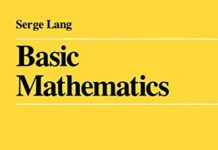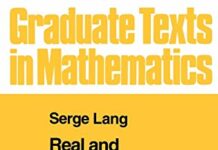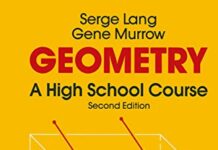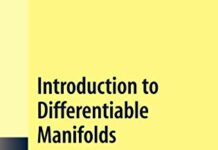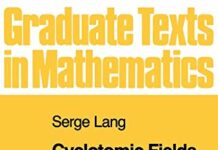
Ebook Info
- Published: 2050
- Number of pages: 293 pages
- Format: PDF
- File Size: 10.39 MB
- Authors: Serge Lang
Description
This is a short text in linear algebra, intended for a one-term course. In the first chapter, Lang discusses the relation between the geometry and the algebra underlying the subject, and gives concrete examples of the notions which appear later in the book. He then starts with a discussion of linear equations, matrices and Gaussian elimination, and proceeds to discuss vector spaces, linear maps, scalar products, determinants, and eigenvalues. The book contains a large number of exercises, some of the routine computational type, while others are conceptual.
User’s Reviews
Editorial Reviews: Review Second EditionS. LangIntroduction to Linear Algebra”Excellent! Rigorous yet straightforward, all answers included!”―Dr. J. Adam, Old Dominion University
Reviews from Amazon users which were colected at the time this book was published on the website:
⭐I purchased this book to accompany a typical introductory linear algebra class, and have since used it for reference and review in subsequent mathematics and physics classes. Lang covers the basics of vectors, matrices, vector spaces, and linear mappings. No background in mathematics is assumed, although the reader should probably be familiar with the sort of elementary algebra and trigonometry taught in grade school. On a few occasions, applications to problems in calculus are mentioned (usually in the exercises), but these can be easily skipped by those unprepared without any loss of continuity.The book is written in the classical style typical of university-level mathematics: the main ideas are organized into theorems, which are stated precisely and proved completely. Nevertheless, Lang also includes plenty of exposition and examples, especially in the early chapters. Most theorems and definitions are followed by a list of examples.Chapter 1 introduces vectors as directed line segments which can be represented by n-tuples (a list of n numbers) and specify a point in n-space. Concepts like dot products, norms, and orthogonality are introduced in this setting.Chapter 2 introduces matrices and matrix algebra. Then, the standard procedure for solving systems of linear equations using matrices is given, followed by the important interpretations involving the column vectors of the coefficient matrix. Some of the proofs in this chapter (especially in section 5 covering elementary matrices) are fairly messy–I imagine impatient readers might have some difficulty here.Chapter 3 reintroduces vectors as elements of an abstract vector space. The approach is logical and straightforward: the chapter begins with the axioms that define a vector space, and then quickly moves on to linear combinations, linear independence, bases, and dimension. Although this all seems very sensible for someone already familiar with the material, I suspect that students new to linear algebra (especially those studying by themselves) will be taken by surprise by the abrupt generalization. After becoming comfortable with vectors as “arrows in space”, suddenly, integers and matrices and functions can all be vectors, too. I think an introductory text would benefit from more careful motivation of new ideas like this.Chapters 4 and 5 discuss linear mappings. Lang also returns to systems of linear equations, which can now be given new interpretations.Chapter 6 covers scalar products and orthogonality for abstract vectors, including a very gentle introduction to Fourier series. The standard Gram-Schmidt algorithm for finding orthogonal bases is covered in detail.Chapter 7 covers determinants. My only complaint about this chapter is its tardiness: determinants are very useful throughout linear algebra (for instance, when determining whether a set of vectors is linearly independent, or when discussing the orientation of a basis and orientation-preservation of a mapping) and should be introduced earlier.Chapter 8 covers eigenvectors and eigenvalues. In section 3, Lang associates eigenvector problems with the optimization of quadratic forms over a sphere using calculus. This is an interesting geometric interpretation which is skipped in the other introductory texts I have looked at.Each chapter is divided into several short sections, which are followed by exercises. Answers, and sometimes explanations, are included in the back of the book. I have not done many of the exercises because I have primarily used this book for reference, but those that I have done tend to be fairly straightforward. There are many simple computations and some more theoretical questions and proofs (but none that would take more than a few minutes). Students who want a serious challenge should find a supplementary source of problems.Overall, this short text covers the fundamentals of the topic very well. The book is terse but rarely incomplete. There are a few shortcomings discussed above that might make the book a little unfriendly towards readers with no “mathematical maturity”.With the exception of several remarks about differential equations and Fourier series, the book is devoid of applications. Nevertheless, it is always concrete and direct, and I would still recommend it for students of applied mathematics, physics, and engineering, who will certainly benefit from a more theoretical understanding of the mathematics they use: science is no excuse for sloppy mathematics! Also, these students will find no shortage of applications of linear algebra in their scientific classes. On the other hand, I would suggest that students of the social sciences and business interested only in the raw applications of linear algebra look elsewhere.
⭐This book is an easy way of learning linear algebra, it is intended for undergraduate students. It is composed with the most important topics in linear algebra, sucha as linear equations, matrices, vector spaces, and much more. I highly recommend it, it has computational and conceptual type exercises.
⭐good enough
⭐This book is easy to understand, and very concise. There are a few printing errors, but I’m pleased with it. The answers are in the back of the book, but sadly no hints or detailed solutions. My professor chose to provide those as additional course materials, which I have found helpful.Overall, a better than average math text.
⭐just as the title,this is a intrduction of the linear algebra.it not a hard book, very detailed .only i don’t like the smybol they used in here1
⭐Anything by Lang is always fabulous.
⭐Amazing book
⭐I started using this book as it was the assigned for a course. However, it’s mid-semester, and I realized my book is missing pages! I’m pretty sure it’s a binding issue….I’m very disappointed, and it’s a huge annoyance to pay for a textbook that is missing pages. I wanted to study for an upcoming an exam, but will have to borrow a friend’s book in the meantime. Do not buy this book, get the hard-copy book if possible.
⭐Lo uso con una maestra que realmente transcribió el libro para darnos la clase, sin embargo es muy sencillo el contenido, le hace falta profundización.英語版で線形代数学の教科書を購入。数学の勉強というより、むしろ英語の勉強になった一冊。もちろん、英語表記なので、日本人でこれを購入する人は限られた人間だと思います。数学の参考書としては、あまり体系的でないので、あまり好きではないです。
⭐
Keywords
Free Download Introduction to Linear Algebra (Undergraduate Texts in Mathematics) 2nd edition 2nd Edition in PDF format
Introduction to Linear Algebra (Undergraduate Texts in Mathematics) 2nd edition 2nd Edition PDF Free Download
Download Introduction to Linear Algebra (Undergraduate Texts in Mathematics) 2nd edition 2nd Edition 2050 PDF Free
Introduction to Linear Algebra (Undergraduate Texts in Mathematics) 2nd edition 2nd Edition 2050 PDF Free Download
Download Introduction to Linear Algebra (Undergraduate Texts in Mathematics) 2nd edition 2nd Edition PDF
Free Download Ebook Introduction to Linear Algebra (Undergraduate Texts in Mathematics) 2nd edition 2nd Edition
